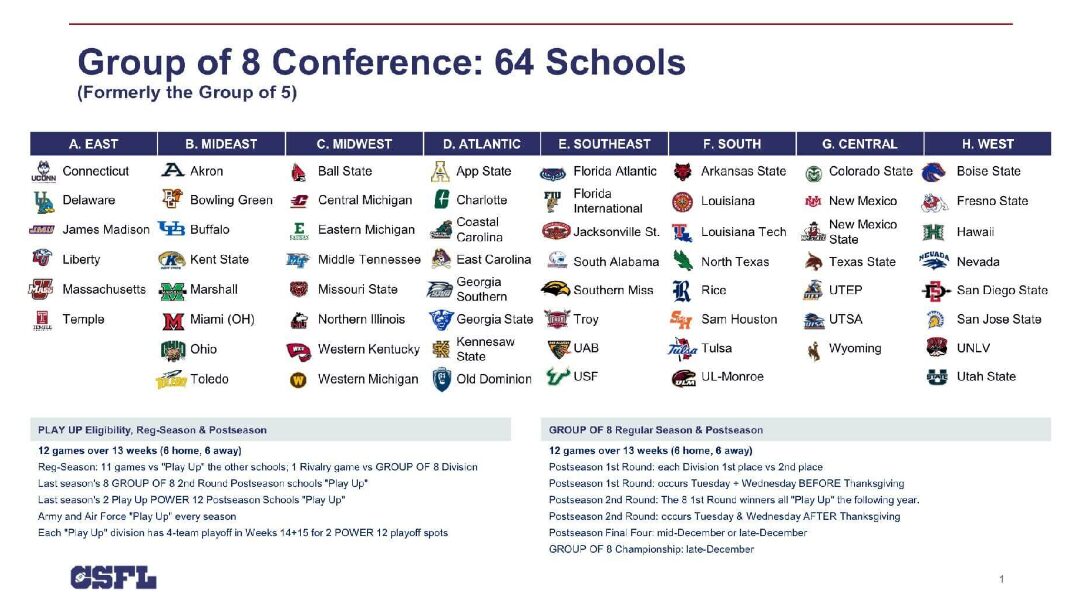
College football ‘Super League’ details unveiled, would be called ‘College Student Football League’
A coalition of executives and administrators has officially proposed a college football “Super League” on Tuesday, introducing a new national league called the College Student Football League (CSFL).
The proposal, which has been in development for months, includes a football-only reorganization of the 136 Football Bowl Subdivision (FBS) schools into two separate conferences. The top 72 programs, primarily from the current Power 5, would compete in the Power 12 Conference, organized into a dozen divisions with six teams each based on geography.
The remaining 64 programs, mainly from the current Group of 5, would form the Group of 8 Conference. A select number of teams from the Group of 8 could qualify for a “promotion” to challenge the Power 12 the following season, similar to the promotion and relegation system in European football leagues, though there would be no relegation for Power 12 schools.
The advisory group for the CSFL, called College Sports Tomorrow (CST), includes influential figures from business, sports, university leadership, and athletic directors. The Athletic first reported on CST’s ambitions for a “Super League” in April.
Despite the announcement outlining specific details about the CSFL’s format, governance, and revenue model, it remains uncertain whether the league can realistically be established. Creating this league would necessitate collaboration between the NCAA and its member institutions, which are currently linked to conferences with their own television contracts and grants of rights. The existing College Football Playoff contract with ESPN extends through the 2031-32 season, and many other conference agreements also outlast that timeframe. CST has stated it does not intend to disrupt any current media contracts.
While CST has attracted attention from prominent industry leaders, the feasibility of unifying college sports into this new structure remains dubious. CST asserts that the CSFL aims to support all 136 FBS members and prevent the emergence of an actual “Super League.” They argue that the CSFL would help address the issues of disruption and imbalance within college sports, including ongoing legal disputes facing the NCAA.
On the field, the CSFL would implement a geographical and results-based scheduling model to promote competitive matchups while honoring traditional rivalries, even across divisions. Postseason berths and seeding would rely on win-loss records, akin to the NFL, culminating in a 24-team playoff that includes division champions and wild card teams. The Power 12 season and playoffs are set to span 21 weeks, from late August to early January, incorporating multiple bye weeks.


“Historically, the beauty of college football has been the number of schools nationwide competing for the championship,” stated Jimmy Haslam, a CST member and owner of the Cleveland Browns. He emphasized the need to return college football to its broad, national model from its golden years, promoting a system that encourages competitive balance.
The CSFL would focus solely on football, allowing other sports to either continue in their current conferences or return to their traditional geographic ones, according to the press release.
Off the field, the CSFL aims to establish a comprehensive players association to collectively bargain. This association could advocate for a special classification from Congress, allowing athletes to pursue collective representation without being classified as employees.
According to CST, this framework would give college athletes a voice in rules and compensation, while also protecting the league from antitrust claims through a “non-statutory labor exemption.” The CSFL might implement a salary cap and establish pay scales for players, along with guidelines that limit athletes to two transfers within a five-year eligibility window.
“The courts are forcing change in college sports, which presents an opportunity to reimagine college football to benefit everyone,” said Len Perna, CST co-founder and chairman of TurnkeyZRG, a recruitment firm in college athletics.
CST’s proposal claims that the CSFL would be economically advantageous and sustainable, predicting that a consolidated league would generate more revenue. This revenue would enable universities to adequately compensate players, maintain competitive balance, cover rising NIL costs, and support less financially viable sports, including women’s sports and the U.S. Olympic program.
The proposal suggests a more equal revenue distribution among schools within each conference, although 94 percent of total revenue would go to the Power 12 programs, with 6 percent allocated to the Group of 8.
Governance of the CSFL would involve a board comprising all 136 schools, with a single commissioner in charge and smaller executive committees for each conference. The Power 12 executive committee would play a significant governance role.
CST envisions the CSFL being owned and controlled by its member programs, allowing each school to retain its rights. They believe the generated revenue would eliminate the need for private equity funding, using only “minimal” outside capital during the initial transition.
CST members include Perna, Haslam, and former NBA player Grant Hill, with support from various athletic directors and university leaders. Despite past connections, CST’s website affirms that the NFL is not connected to CST or the CSFL.
In April, it was reported that Brian Rolapp, an NFL executive, was part of the CST group; however, he was not mentioned in recent materials, with a CST spokesperson confirming he is no longer involved.

Leave a Reply